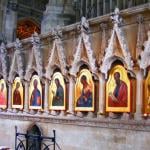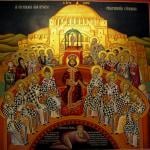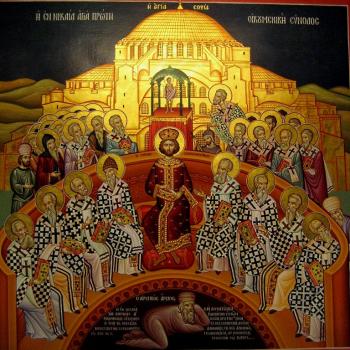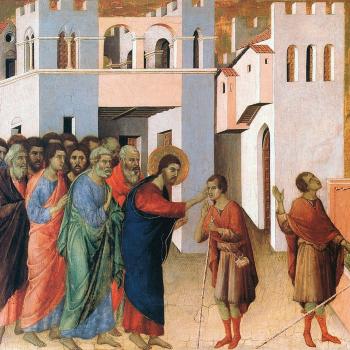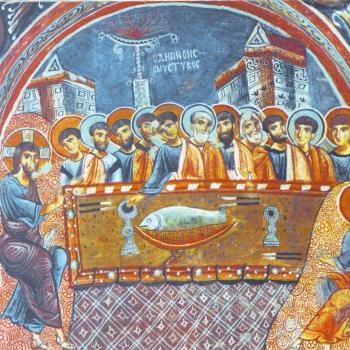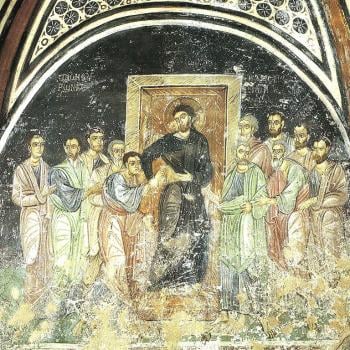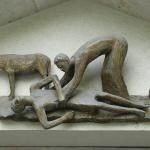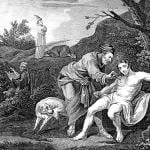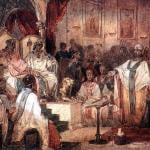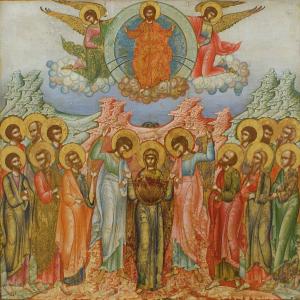
It could be said that the final act of Jesus’s temporal ministry was not his resurrection from the dead, but his ascension into heaven. It is, in many ways, a very mysterious act. At first glance, this might seem to contradict what Jesus said when he said he would be with us until the end of the age. And yet, when examined, this is actually the way Jesus uses to be with each and every one of us at once, giving us a way to experience his presence in our lives without the limitations imposed upon mere material existence. For he is with us in his new, transformed state, in his glorified form, in a form which transcends material being and its limitations; he already showed us that his resurrected form was not bound by empirical laws when he was seen coming and going instantaneously, even in locked rooms. But, during the time immediately after his resurrection, he wanted us to know he truly had risen, and possessed the same body he had before his death, a body which could continue to interact with material being (as seen in the way it could be touched, or he could be seen eating food). His glorified form is a spiritualized form of being, one which possesses and can use all that is connected with material being. His interaction with his disciples after the resurrection allowed them to begin with their empirical (materialistic) understanding of Christ, but slowly come to realize there was something new, something different, something transcendent in him, until they could understand Christ in his glorified (and spiritualized) mode of being:
For this purpose [the Lord] set his flesh before them, to turn their every thought away from human matters and attach it to his flesh, which was saying wondrous things and performing wondrous deeds. Thus he would turn [their] attention from flesh to spirit, because God is spirit, and those who worship God must worship in spirit and truth.[1]
In the ascension, he did not abandon his incarnate human nature, and with it, the characteristics which are connected to it. He continues to possess them, including his body, but he does so without any of the defects which we often associate with them: “He did not indeed put aside the substance of his sackcloth, but its decrepitude, its decay, its misery, and its worthlessness, [when] he consecrated the first fruits of our resurrection.”[2] The glorification and spiritualization of his body is what will happen to all of us in our own resurrection from the dead, which is why Jesus is said to be the first born of the dead; the difference between our resurrection and his, of course, lies in the fact that our resurrection is given to us by Jesus. Jesus is the resurrection and the life, while we merely participate in the resurrection and the life in him.
Before Jesus’ ascension, it seems that apostles believed Jesus would be reigning in glory on earth as he does in heaven. That is, they, like so many, believed they saw the signs which indicated the “end of time” and with it, the messianic kingdom, had come. In a sense, they were right, but not in the way they thought: Jesus is the immanent eschaton. However, the eschaton is already and not-yet – the eschaton truly has entered into time, but the last moments of end of history have yet to come. Jesus still has work to do, but this time, the work would be in and through his disciples who will now be his hands and feet in the world (as they share his Spirit by being incorporated into his body):
So when they had come together, they asked him, “Lord, will you at this time restore the kingdom to Israel?” He said to them, “It is not for you to know times or seasons which the Father has fixed by his own authority. But you shall receive power when the Holy Spirit has come upon you; and you shall be my witnesses in Jerusalem and in all Judea and Samaria and to the end of the earth” (Acts. 1:6-8 RSV).
Christians have to learn to think beyond the empirical world, beyond time and space, to understand the way we can experience Jesus’ presence. His ascension into heaven points to the new, greater, spiritual reality of Christ. He now reigns in eternal glory in his humanity, just as he did and has always done in his divinity; it is a glory, a presence, which we can all encounter and experience wherever we are it, even within ourselves. Heaven had come to earth, and in the ascension, the one who had come down now went back up, completing the bridge which unites the two. It was an act which not only surprised his human disciples, but even angelic beings – the whole of the incarnation, to be sure, was a surprise to angels, and they experienced those surprises in a way which transcends our understanding, and yet as a mystery which had them glorify God even more:
For the powers on high also marveled at the ascension of Christ to the heavens, when they said, “Who is this who comes from Edom? The redness of his clothing is from Bosor. Beautiful is his robe, beautiful as a pool full of the winepress.” For the powers on high saw a new thing: the Son of God ascending to heaven with flesh. And therefore they said, “Who is this who comes from Edom?” It was a marvel to the angels, a marvel to the powers on high, that flesh of which it was said to Adam, “You are earth and to the earth you will go” [Gen 3:19], was no longer on earth but was flesh ascending to heaven.[3]
The ascension, then, can be seen as the pointer Christ uses to show us that if we want to encounter him and his presence, we can, but we must now do so in a different manner than the way we would have done before his death and resurrection from the dead. Likewise, Jesus shows us that what exists in material creation has a place in the kingdom of God, for he took with him all that he is, including his glorified material being, into the kingdom of God.
[1] St. Bernard of Clairvaux, Sermons for the Summer Season. Trans. Beverly Mayne Kienzle and James Jarzembowski (Kalamazoo, MI.: Cistercian Publicans, 1991), 39 [The Lord’s Ascension: Sermon Three].
[2] St. Bernard of Clairvaux, Sermons for the Summer Season, 44 [The Lord’s Ascension: Sermon Four].
[3] St. Chromatius of Aquileia, Sermons and Tractates on Matthew. Trans. Thomas P. Scheck (New York: Newman Press, 2018), 37 [Sermon 8].
Stay in touch! Like A Little Bit of Nothing on Facebook.
If you liked what you read, please consider sharing it with your friends and family!
N.B.: While I read comments to moderate them, I rarely respond to them. If I don’t respond to your comment directly, don’t assume I am unthankful for it. I appreciate it. But I want readers to feel free to ask questions, and hopefully, dialogue with each other. I have shared what I wanted to say, though some responses will get a brief reply by me, or, if I find it interesting and something I can engage fully, as the foundation for another post. I have had many posts inspired or improved upon thanks to my readers.


